In California, a vibrant tapestry of avian majesty graces the skies, 14 distinct hawks, each with its unique story etched against the backdrop of diverse landscapes.
From the iconic Red-tailed Hawk, soaring with elegance, to the elusive Northern Goshawk, these raptors captivate hearts and ecosystems alike.
In this exploration, we embark on a journey to unveil the intriguing lives of these winged predators, delving into their habitats, behaviors, and the delicate balance they maintain in California’s ecosystems.
Join us as we navigate the skies, discovering the awe-inspiring tales of these 14 hawks, shedding light on their significance in shaping the ecological harmony of the Golden State. So, stay focused.
14 Hawks in California
Find out the diverse avian tapestry of California with a glimpse into the lives of majestic raptors. Each bird brings a unique tale of adaptation, survival, and ecological balance, from the iconic Bald Eagle to the elusive Screech Owl.
Join us as we unfold the enchanting stories of Barn Owls, Peregrine Falcons, and more soaring across the diverse landscapes of the Golden State.
1. Red-tailed Hawk

- Scientific name: Buteo jamaicensis
- Population: Common and widespread
- Life span: Up to 20 years
- Size: Length around 18-26 inches
- Weight: 2-4 pounds
- Food: Small mammals, birds, and reptiles
- Wingspan: 3.5 to 4.5 feet
- Status: Secure
The Red-tailed Hawk is a highly adaptable and widespread species found throughout California. Recognizable by its distinctive brick-red tail, it exhibits a diverse lifestyle.
These hawks are often seen perched on utility poles or in flight, soaring with broad wings and a keen eye for prey. Their diet includes small mammals, birds, and reptiles, making them effective hunters.
Red-tailed Hawks are known for their impressive aerial displays, involving high spirals and dives during courtship. They build large stick nests on high structures, cliffs, or trees, showcasing their resourcefulness.
With a lifespan of up to 20 years, these hawks are resilient and play a vital role in controlling rodent populations, contributing to the ecological balance in California’s diverse landscapes.
2. Cooper’s Hawk
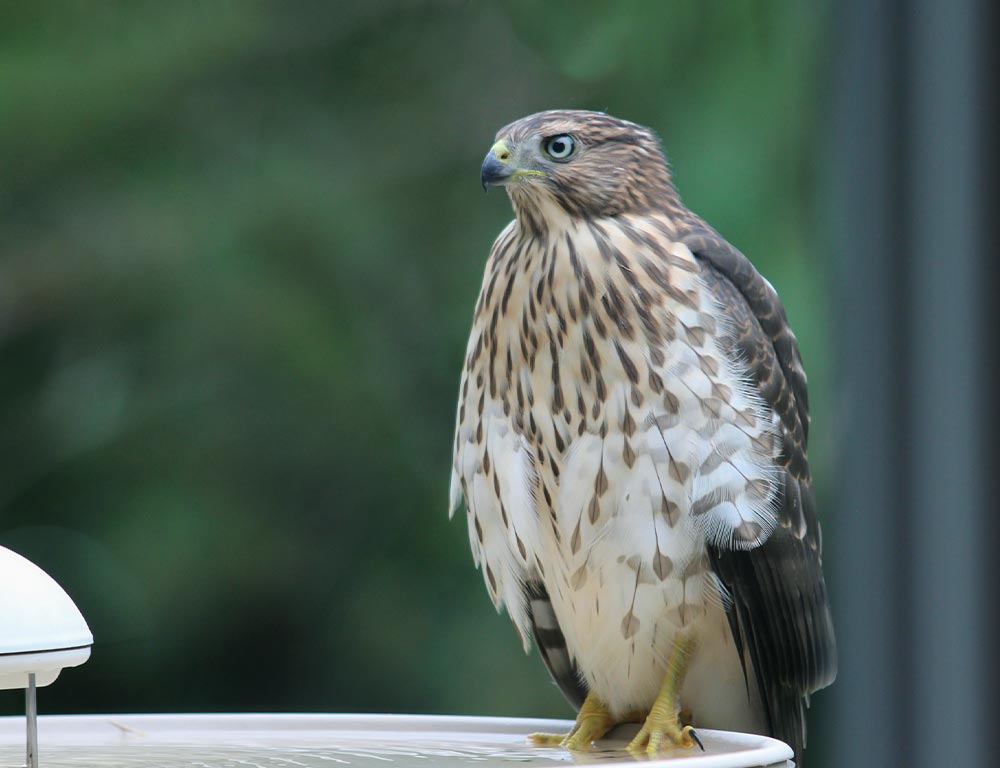
- Scientific name: Accipiter cooperii
- Population: Common, especially in wooded areas
- Life span: Up to 12 years
- Size: Length around 14-20 inches
- Weight: 0.5-1.5 pounds
- Food: Birds, small mammals
- Wingspan: 2.5 to 3.5 feet
- Status: Secure
The Cooper’s Hawk, characterized by its slender build and short wings, is a common inhabitant of wooded areas in California.
With a preference for a diet of mainly birds, they are skilled flyers, maneuvering through dense vegetation in pursuit of prey.
Their short, rounded wings enable them to navigate forested landscapes with agility. Cooper’s Hawks build nests in trees, and their populations thrive in suburban areas with a mix of open spaces and vegetation.
Their secretive nature and excellent camouflage make them adept hunters, stalking their prey before launching a surprise attack. Cooper’s Hawks are crucial in controlling bird populations, helping maintain ecological balance in their habitats.
3. Ferruginous Hawk
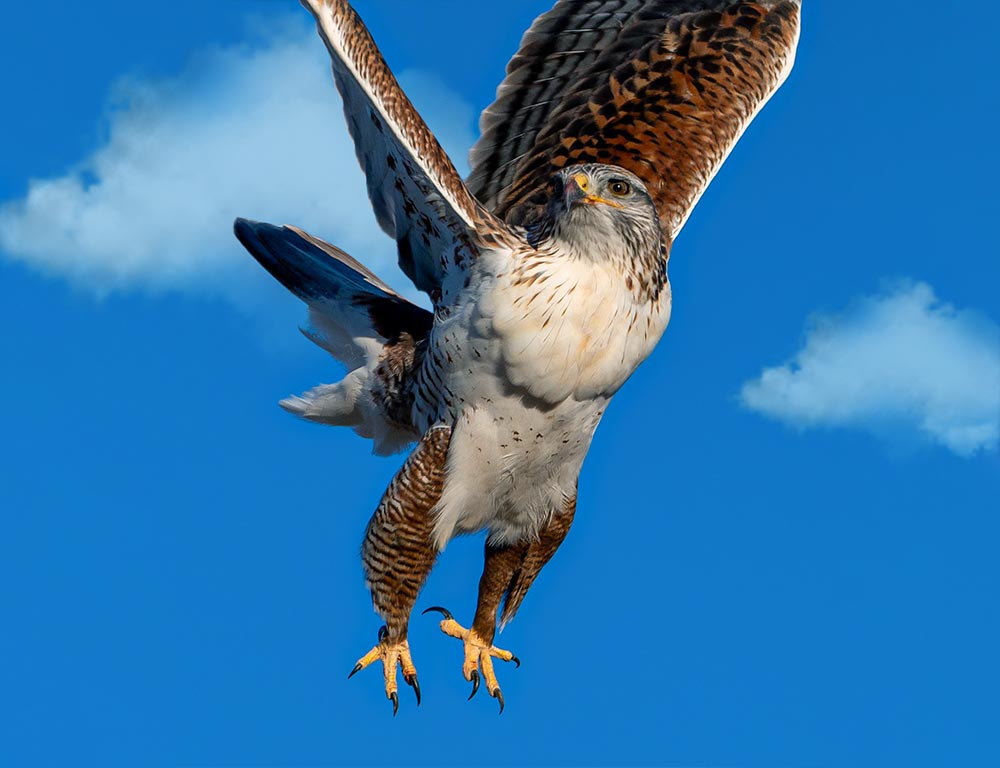
- Scientific name: Buteo regalis
- Population: Declining, especially in some regions
- Life span: Up to 20 years
- Size: Length around 22-29 inches
- Weight: 2.5-5.5 pounds
- Food: Small mammals, ground squirrels
- Wingspan: 3.5 to 4.5 feet
- Status: Special Concern
The Ferruginous Hawk, known for its striking light coloration and large size, faces challenges with declining populations in certain regions.
These hawks are often found in open grasslands and deserts of California. Specializing in hunting small mammals, particularly ground squirrels, they use their powerful talons to capture prey.
Ferruginous Hawks build nests on the ground or low cliffs, a behavior uncommon among hawks. Unfortunately, habitat loss and human activities have contributed to their decline, leading to their “Special Concern” status.
Conservation efforts are crucial to safeguard the Ferruginous Hawk’s unique lifestyle and ensure its continued presence in California’s diverse ecosystems.
4. Red-shouldered Hawk
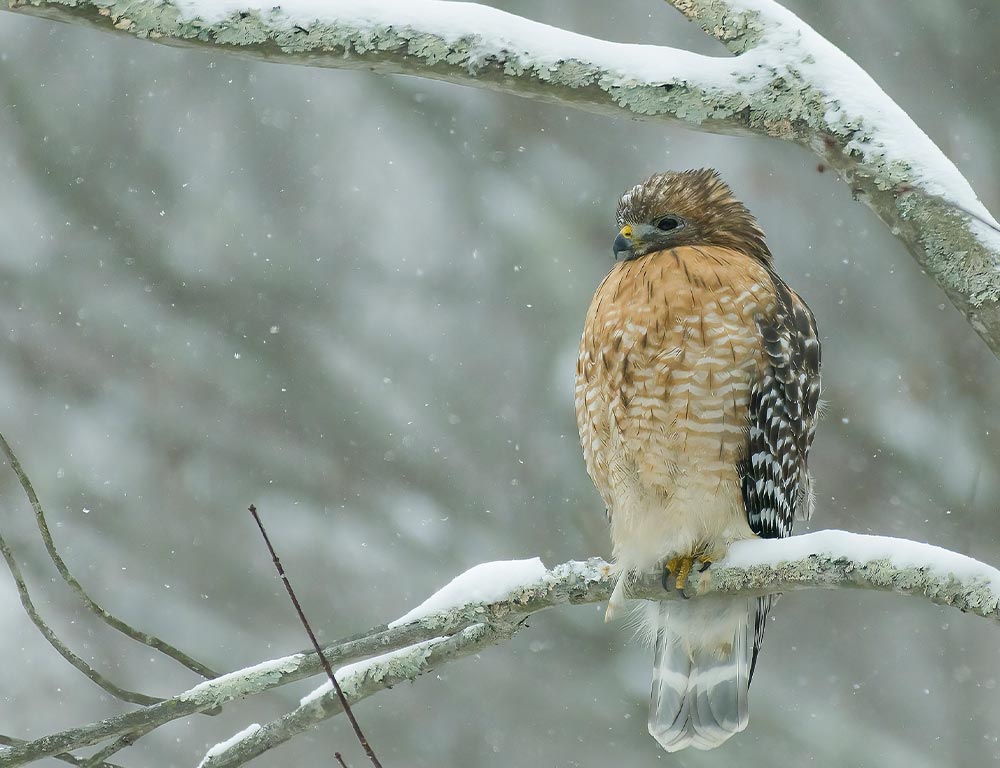
- Scientific name: Buteo lineatus
- Population: Stable; common in wooded areas
- Life span: Up to 20 years
- Size: Length around 17-24 inches
- Weight: 1-2.5 pounds
- Food: Small mammals, reptiles, amphibians
- Wingspan: 2.5 to 3.5 feet
- Status: Secure
The Red-shouldered Hawk is a woodland dweller commonly found in wooded areas throughout California.
Recognized by its distinctive reddish-brown shoulders, these hawks exhibit a diverse diet, including small mammals, reptiles, and amphibians.
They are skilled fliers, often observed soaring over forests or perched in high trees. Red-shouldered Hawks are vocal, producing a distinctive scream that adds to the soundscape of their habitats.
They build nests in the canopy of trees and play a vital role in controlling rodent populations in their ecosystems. With a lifespan of up to 20 years, these hawks contribute to California’s diverse landscapes’ biodiversity and ecological balance.
5. Sharp-shinned Hawk
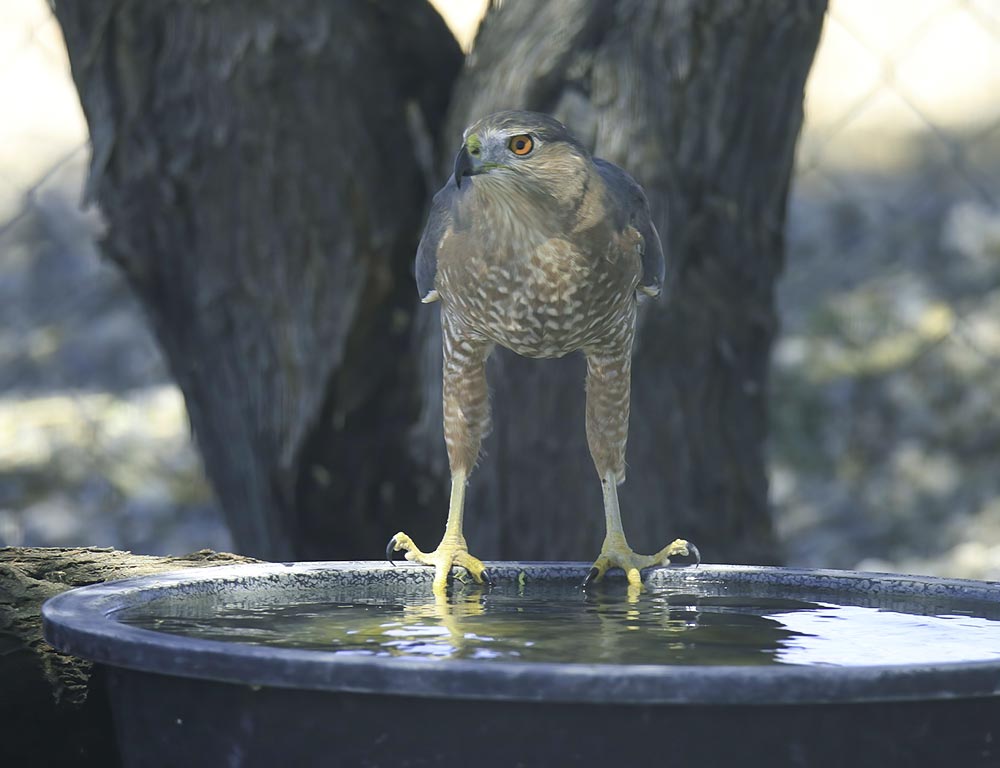
- Scientific name: Accipiter striatus
- Population: Common, especially during migration
- Life span: Up to 12 years
- Size: Length around 9-14 inches
- Weight: 3-7 ounces
- Food: Small birds, occasionally insects
- Wingspan: 1.5 to 2.5 feet
- Status: Secure
The Sharp-shinned Hawk is a small and agile bird of prey commonly found in California, particularly during migration seasons. With a preference for small birds as their primary food source, they are adept at navigating dense vegetation and urban areas.
Sharp-shinned Hawks are known for their rapid flight and sharp turns, allowing them to pursue and catch their avian prey. They build nests in trees, demonstrating adaptability to various habitats.
These hawks contribute to the natural control of songbird populations, which is crucial in maintaining ecological balance in their environments.
6. Swainson’s Hawk
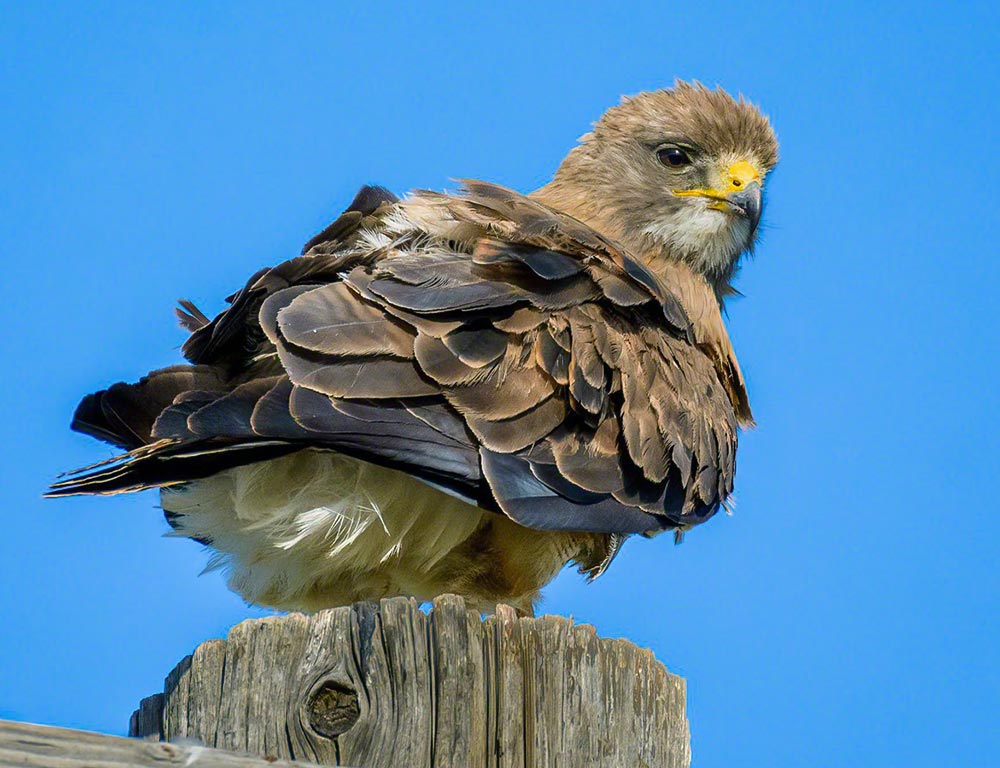
- Scientific name: Buteo swainsoni
- Population: Variable, with some populations declining
- Life span: Up to 20 years
- Size: Length around 18-22 inches
- Weight: 2-3.5 pounds
- Food: Insects, small mammals, reptiles
- Wingspan: 4.5 to 5.5 feet
- Status: Variable, some populations threatened
Swainson’s Hawks are known for their long migrations from South America to North America. They are found in California during their breeding season.
These hawks are fed primarily on insects, small mammals, and reptiles, which play a vital role in pest control in agricultural areas.
Swainson’s Hawks build nests on cliffs or in trees, and their populations face challenges due to habitat loss and pesticide exposure. Conservation efforts are essential to ensure the protection of this species, especially in areas where their populations are declining.
Swainson’s Hawks contribute to the ecological balance of California’s landscapes, showcasing the interconnectedness of migratory birds with diverse ecosystems.
7. Northern Goshawk
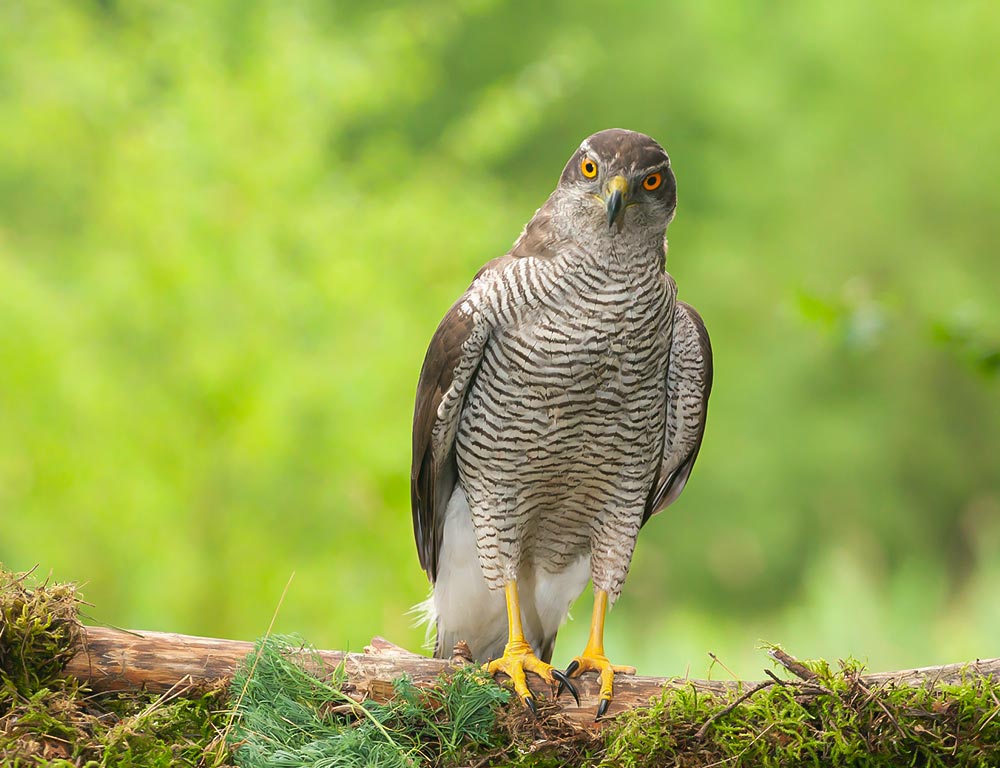
- Scientific name: Accipiter gentilis
- Population: Generally stable, with some regional variations
- Life span: Up to 20 years
- Size: Length around 20-27 inches
- Weight: 2-4 pounds
- Food: Birds and mammals
- Wingspan: 3.5 to 4.5 feet
- Status: Secure
The Northern Goshawk is a large and powerful hawk found in various forested habitats across California. With a preference for hunting birds and mammals, they are skilled at navigating through dense vegetation.
Northern Goshawks build nests high in trees and exhibit territorial behavior during the breeding season.
Known for their agility and swift flight, they are efficient predators, capturing prey with their strong talons. Their populations are generally stable, contributing to the natural balance of ecosystems in California’s diverse landscapes.
Conservation efforts focus on maintaining suitable habitats and minimizing disturbances to support the continued presence of the Northern Goshawk.
8. Northern Harrier
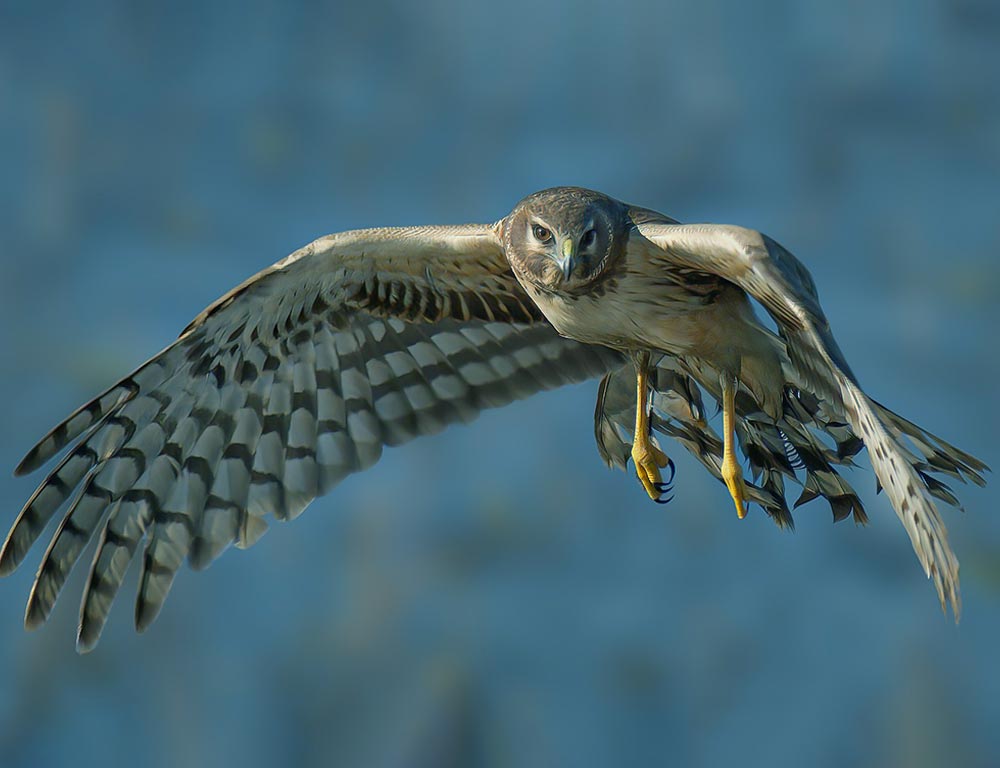
- Scientific name: Circus hudsonius
- Population: Common, especially in open areas
- Life span: Up to 10 years
- Size: Length around 18-24 inches
- Weight: 10-26 ounces
- Food: Small mammals and birds
- Wingspan: 3.5 to 4.5 feet
- Status: Secure
The Northern Harrier, also known as the Marsh Hawk, is commonly found in California’s open areas, including marshes and grasslands.
With a distinctive facial disk and low, gliding flight, they are skilled hunters of small mammals and birds. Northern Harriers build nests on the ground, utilizing tall grasses for cover.
Their populations thrive in areas with a mix of open spaces and vegetation. These hawks play a crucial role in controlling rodent populations, making them valuable contributors to the ecosystems they inhabit.
9. Gray Hawk
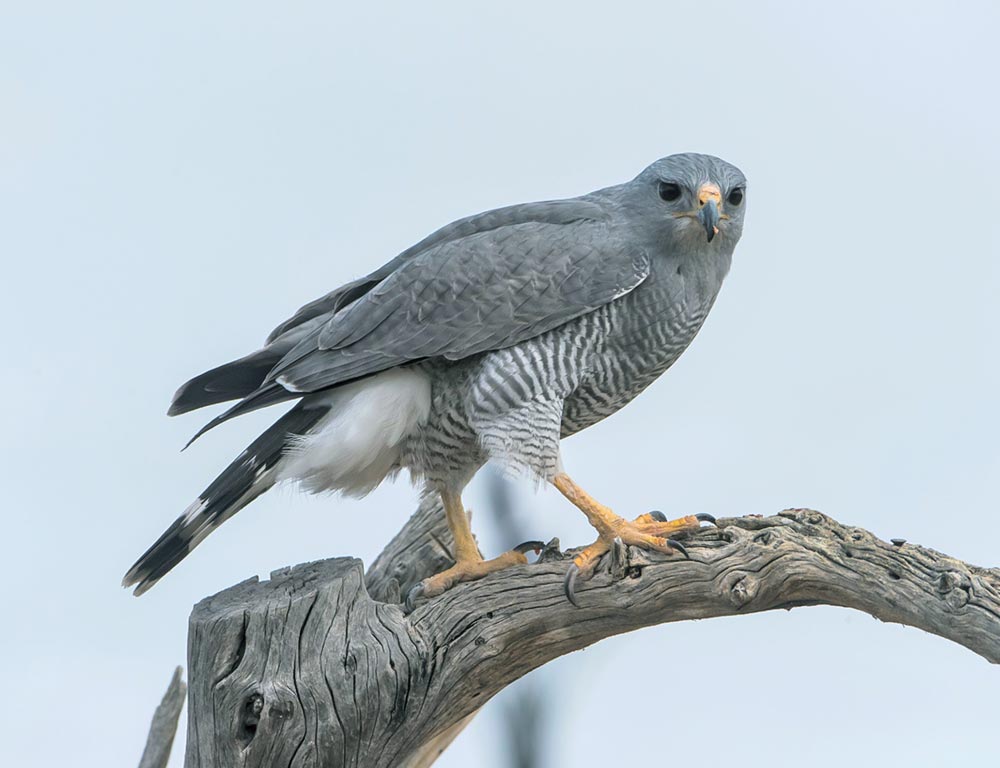
- Scientific name: Buteo plagiatus
- Population: Resident in some parts of California
- Life span: Information varies; likely up to 10-15 years
- Size: Length around 16-18 inches
- Weight: 0.5-1 pound
- Food: Reptiles, insects, small mammals
- Wingspan: 2 to 2.5 feet
- Status: Varies by region
The Gray Hawk is a resident bird of prey in parts of California, often found near water sources. Feeding on a diet of reptiles, insects, and small mammals, they are well-adapted to riparian habitats.
Gray Hawks build nests in trees and are known for their distinctive vocalizations.
While their populations may vary by region, conservation efforts are crucial to maintaining suitable habitats and ensuring the protection of this species, particularly in areas facing habitat degradation or loss.
10. Bald Eagle
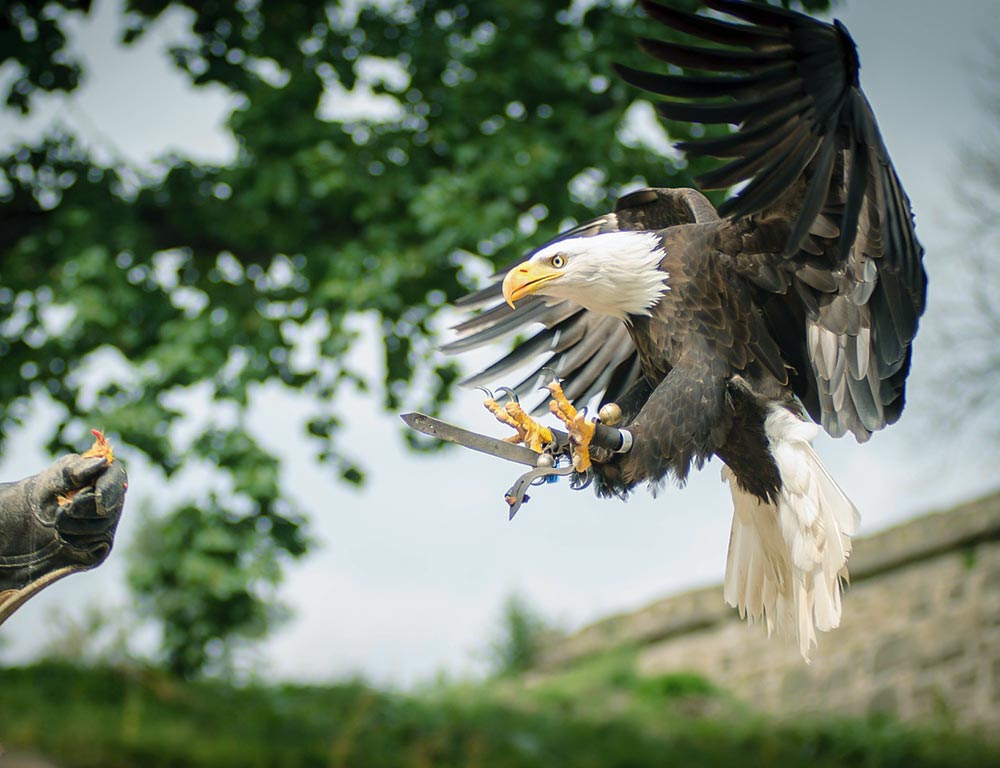
- Scientific name: Haliaeetus leucocephalus
- Population: Increasing, post-recovery from endangerment
- Life span: Up to 20-30 years
- Size: Length around 28-40 inches
- Weight: 6.5-14 pounds
- Food: Fish, birds, mammals
- Wingspan: 6.5 to 7.5 feet
- Status: Recovered, stable
The Bald Eagle, a symbol of strength and freedom, has made a remarkable recovery in the United States, including California, after being listed as endangered.
These eagles are commonly found near large bodies of water, hunting for fish and other prey. Known for their impressive size and distinctive white head and tail, Bald Eagles build large nests in trees near water.
Their recovery is a conservation success story, highlighting the importance of habitat protection and environmental regulations.
Bald Eagles play a vital role in maintaining the health of aquatic ecosystems and are now a thriving part of California’s diverse birdlife. Conservation efforts continue to ensure the long-term stability of their populations.
11. Barn Owl
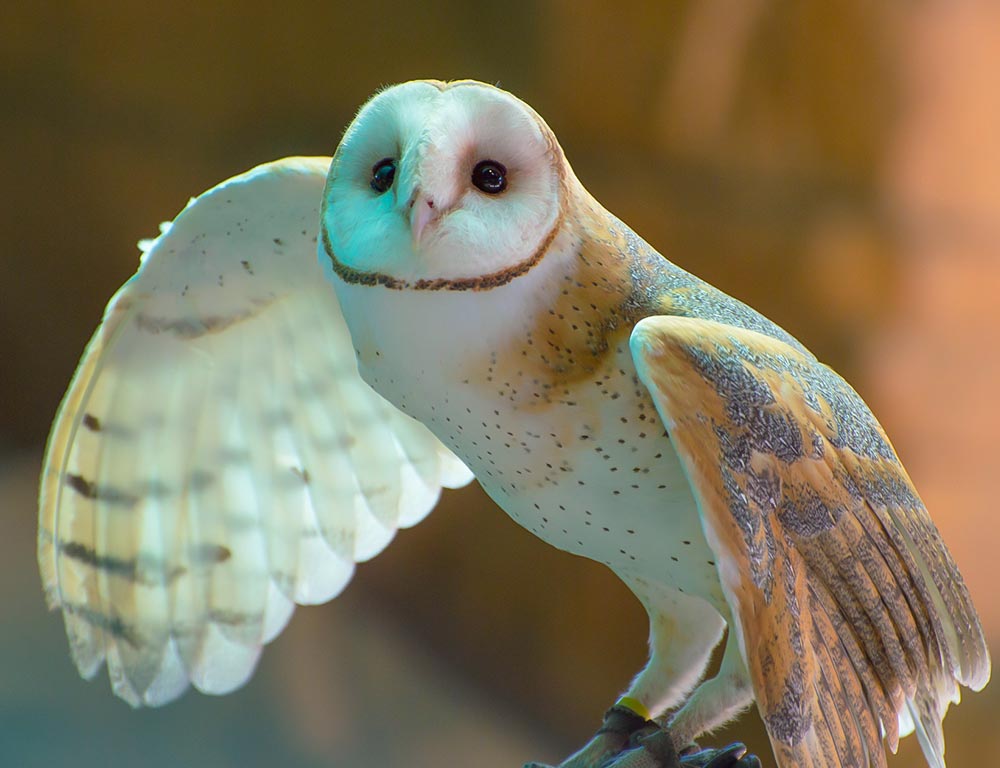
- Scientific name: Tyto alba
- Population: Common and widespread
- Life span: Up to 10 years
- Size: Length around 12-15 inches
- Weight: 1-2 pounds
- Food: Rodents, small mammals
- Wingspan: 3 to 3.5 feet
- Status: Secure
The Barn Owl, known for its heart-shaped facial disc and white, ghost-like appearance, is a common and widespread species found in a variety of habitats in California.
Nocturnal hunters and barn Owls feed primarily on rodents and small mammals. Their exceptional hearing and silent flight make them efficient predators in the dark.
Barn Owls often nest in barns, old buildings, or tree cavities, providing valuable pest control services to farmers. Their populations are generally stable, contributing to the ecological balance by controlling rodent populations in agricultural and natural landscapes.
12. Osprey
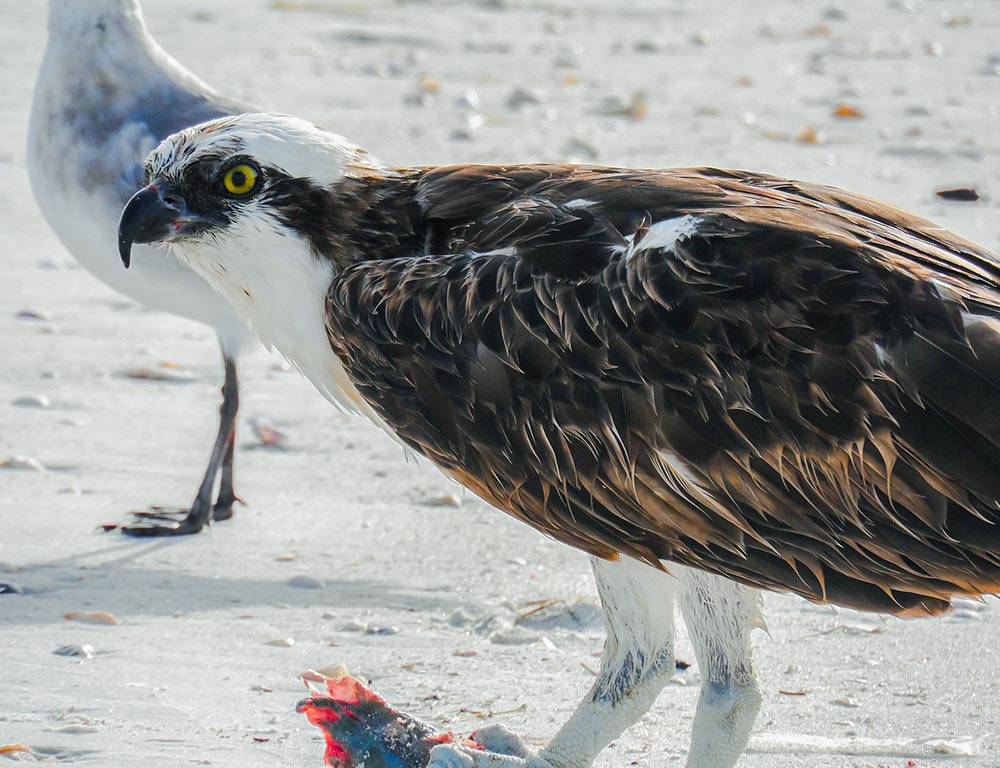
- Scientific name: Pandion haliaetus
- Population: Increasing conservation success
- Life span: Up to 20 years
- Size: Length around 21-24 inches
- Weight: 3-4.5 pounds
- Food: Fish
- Wingspan: 5 to 6 feet
- Status: Secure
The Osprey, often called the “fish hawk,” has experienced a successful recovery in many regions, including California, due to conservation efforts.
With a diet consisting almost exclusively of fish, Ospreys are commonly found near freshwater habitats. They are skilled at hunting fish with their talons and exhibit impressive aerial displays.
Ospreys build large nests on artificial structures like utility poles or specialized platforms. Their recovery showcases the positive impact of conservation initiatives on bird species, emphasizing the importance of protecting their aquatic habitats.
13. Peregrine Falcon
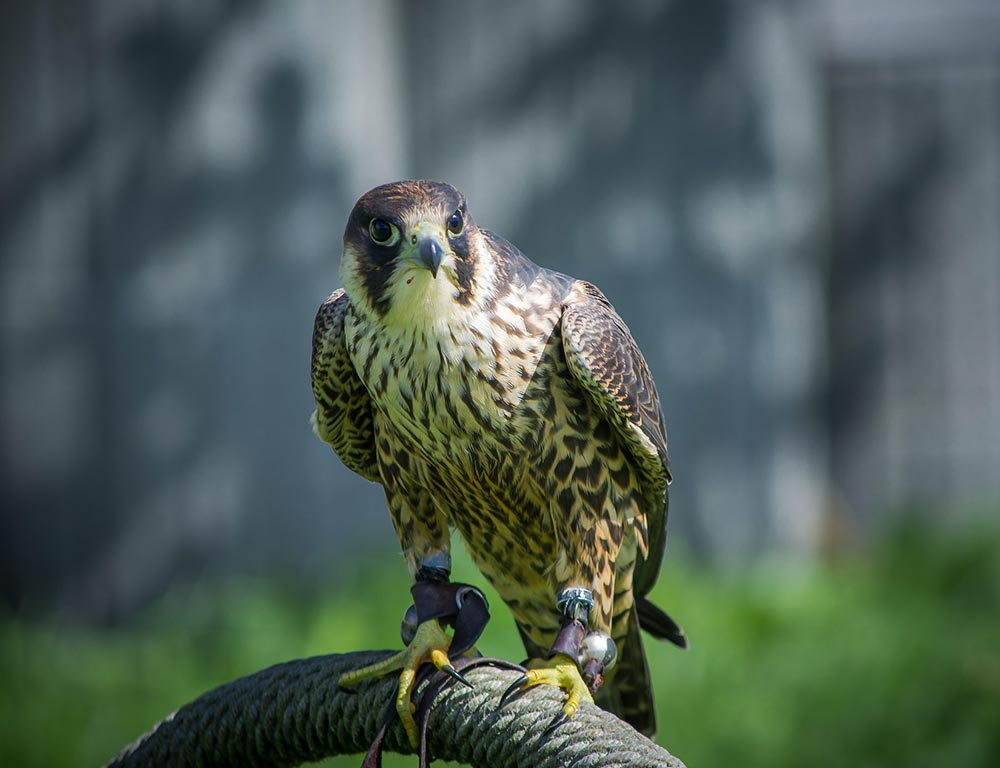
- Scientific name: Falco peregrinus
- Population: Recovered after endangerment
- Life span: Up to 15 years
- Size: Length around 14-20 inches
- Weight: 1-3.5 pounds
- Food: Birds, bats
- Wingspan: 2.5 to 3.5 feet
- Status: Recovered, stable
The Peregrine Falcon, once critically endangered due to pesticide use, has remarkably recovered following conservation efforts. Known for its incredible speed and aerial prowess, the Peregrine Falcon preys on birds and bats.
They are often observed in urban areas, where tall structures serve as nesting sites. Peregrine Falcons have adapted well to urban environments, utilizing skyscrapers and bridges for nesting.
Their recovery is a testament to the effectiveness of conservation programs and the ban on harmful pesticides, ensuring the continued presence of these charismatic falcons in California’s skies.
14. Screech Owl
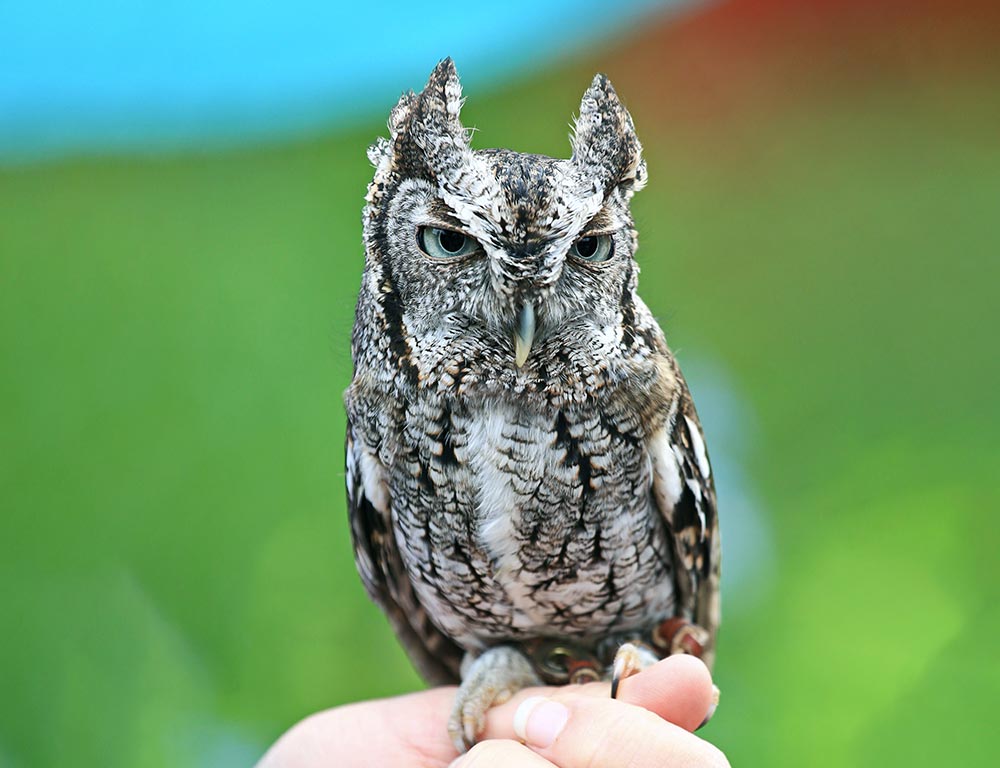
- Scientific name: Megascops sp.
- Population: Variable based on species
- Life span: Up to 10 years
- Size: Length around 6-10 inches
- Weight: 4-8 ounces
- Food: Insects, small mammals
- Wingspan: 1.5 to 2 feet (variable)
- Status: Varies by species
Screech Owls belong to the genus Megascops, and different species, such as the Western Screech Owl or Eastern Screech Owl, can be found in California.
These small owls are adaptable and thrive in various habitats, including urban areas, forests, and parks.
Feeding primarily on insects and small mammals, Screech Owls are nocturnal hunters. They often nest in tree cavities, and their camouflaged plumage provides effective concealment during the day.
Conservation efforts focus on preserving suitable nesting sites and maintaining habitat diversity to support the varied species of Screech Owls in California. Their presence adds to the biodiversity and nocturnal charm of the state’s ecosystems.
Wrapping Up
In California’s skies and landscapes, hawks epitomize nature’s resilience and beauty.
From the Red-tailed Hawk’s soaring majesty to the Barn Owl’s silent nocturnal prowess, these birds of prey contribute to the rich tapestry of the Golden State.
Their stories reflect the delicate balance of ecosystems and the interconnectedness of all living beings.
Through conservation efforts and an understanding of their unique lifestyles, we can ensure the continued existence of these magnificent raptors.
As we witness their flights and hear their calls, we are reminded of the importance of preserving the habitats that sustain them and the intricate web of life they help maintain in California’s diverse environments. Thank you so much.